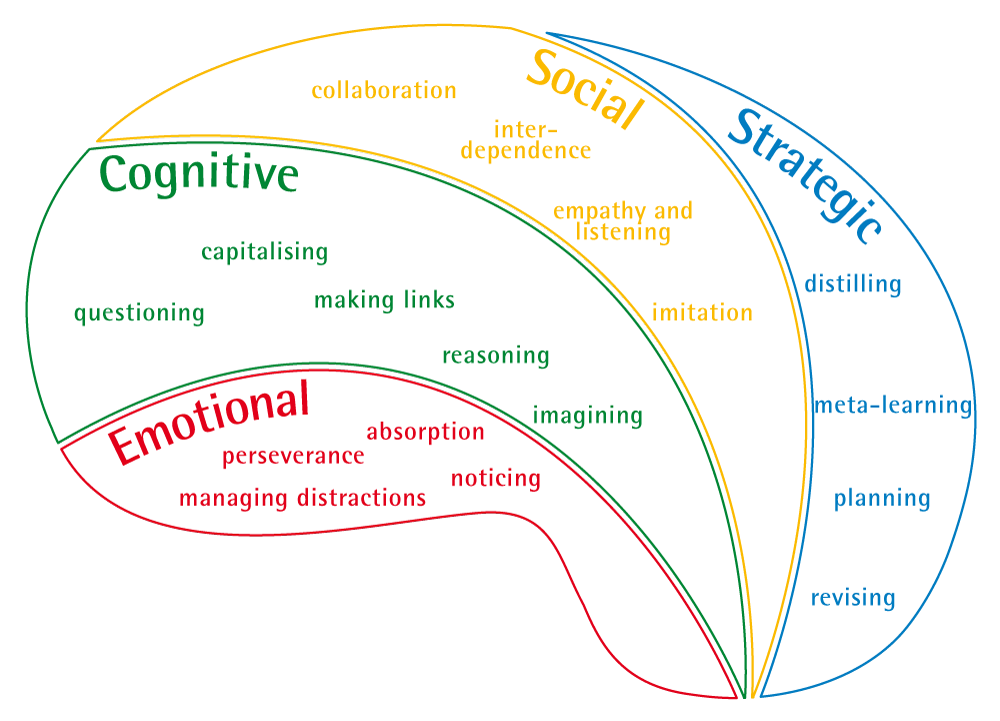 Noticing
Noticing
When you use this learning muscle, you …
- notice how things look, what they are made of, or how they behave
- are patient, knowing that details may take time to emerge
- can identify significant detail
- get a clear sense of what, before starting to think why or how
The activities, think pieces and questions in this online unit aim to help you, as a teacher, to make a start on:
- introducing your students to one of the key learning behaviours;
- using the language of learning effectively with your students;
- designing the use of learning behaviours into the way you teach;
- developing the confidence and skill in helping your students to grow their learning habits.
The purpose of building your students’ Learning Power is to facilitate the growth of high value psychological characteristics and strengthen their learning characters. These skills, attitudes and values, when used with increasing competence and confidence across many learning opportunities, become learning habits; the characteristics of successful lifelong learners.
How to navigate the module. Ignore if you are familiar with this advice.
Ideas in this module may take you into a new way of thinking about learning. The notes below will help you gain a coherent feel for how the material fits together and apply in your classroom practice.
Take it slowly and try to avoid any inclination to skim through the whole resource.
Spend about 15 mins on each of the 5 steps below; sufficient time to both read, think about and note down your learning.
Start with section 1.
Read – ‘What is . . . ?’
Maybe go over it again because there may well be some features of this behaviour that you haven’t met before.
Spot the xxxxxxxxxx in a class you know well and fill in the names of your learners.
Ask yourself:
Which of my learners appear to do all / most of these things already?
Which of my learners don’t appear to exhibit any of these positive learning behaviours?
What you’re discovering.
Make a note of your musings ready for discussion at the Professional Learning Team meeting.
Now go to section 3.
Carefully read ‘Understand how Xxxxxxx grows’, this is likely to be brand new information
Take time to find out how the phases of growth work (see toggle box)
Focus on the class you know well and think about where they might fit on this trajectory
Think through the questions shown below the trajectory but don’t assume higher achievers will automatically be further up the trajectory than lower achievers
Ask yourself the hard question – could my learners make progress up this trajectory this year?
If yes, how might I help make this happen?
If no, what might I do to make learners more secure at their current stage?
Make a note of your musings ready for discussion at the Professional Learning Team meeting.
Now go to section 2.
Get a sense of what is meant by classroom culture and look at the diagram that shows some aspects of culture that encourage and enable xxxxxxxx to flourish. . . ‘
Think about your own classroom culture:
which of these aspects are a regular feature in your own classroom?
which might you consider introducing into your classroom?
which sound interesting but you do not understand what they might look like in practice?
Make a note of your musings ready for discussion at the Professional Learning Team meeting.
You’ve now looked at the nature of the learning behaviour, considered how it might grow, and looked at features the classroom culture that supports it.
Now turn to section 4 to explore some teaching ideas that could be used to build these behaviours in your own classroom.
Read through section 4 – Ideas to Practise
look at both the primary and secondary columns because many of the ideas can be amended to fit different ages
Which of these ideas might fit your needs or simply appeal to you?
Which do you already use?
Which might work well in your own classroom?
Make a note of your musings ready for discussion at the Professional Learning Team meeting.
Section 5 Develop your talk
Take a look at a few statements you could use to nudge the behaviour. Using this language can be a big shift for many teachers because what you are doing here is talking in a way that will nudge the use of a particular learning behaviour. This is intentional and precise learning language.
Ask yourself:
How much do you currently talk about the process of learning, as opposed to the outcomes of learning?
Have you ever considered, in advance, how you might talk about the process of learning, or do you tend to just ‘trust yourself to say the right thing at the right time’?
Might you need to make a conscious decision to prepare in advance the language that you use?
Which of the suggested phrases/comments would best resonate with your students and fit with any of the teaching ideas you might try from section 4?
Make a note of your musings ready for discussion at the Professional Learning Team meeting.

![Helping your learners to… Notice [v2] magnifying-glass-189254_960_720](https://www.buildinglearningpower.com/wp-content/uploads/2017/05/magnifying-glass-189254_960_720-200x200.png)
Comments are closed.